Items
Site
The Medicine Chest
keywords is exactly
astronomy
-
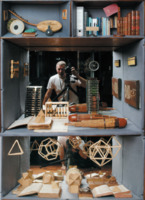
Page 135 of the Curiosity CLXXV catalogue
"Peering into one of them could, for instance, reveal musical instruments from the South African College of Music’s Kirby collection; old wooden mathematical models of abaci and polyhedrons from the Maths department; mobiles demonstrating platonic solids made by mechanical engineering students; publications by a UCT Professor of Astronomy; a sign pointing to ward D10 from the old section of Groote Schuur Hospital; glass slides once used as a teaching aid for art history at Michaelis; bird ringing material from the Avian Demography unit; and a bottle-brush plant labelled by the son of one of the curators" (Liebenberg 2021: 179). -

Second star to the right and straight on 'til morning
Cyanotype on paper. Ink on perspex. The work shows the exact positioning of the stars from J.M. Barrie’s window at 3 Adelphi Terrace, London (51°30'N 0°7'21"W), on Saturday, 19 June 1937 – the night of his death. Based on the direction of his window, I was able to locate the ‘second star to the right’ at the 45 degree angle he would have stood and viewed the night sky. Hopefully, he reached his destination, after departing the flat and traveling ‘straight on till morning’. -

Falling stars
Marine biologists studying whalesharks use the pattern-recognition technique, developed in 1986, that astronomers use to analyze data from the Hubble Space Telescope. Studying the spatial relationships between a whaleshark's spots form the basis for creating a unique identifier for each shark. -

#165317 Dipsy
In 2015, Conservation International scientists in Indonesia attached satellite transmitters to the dorsal fins of whale sharks to learn more about their migratory movements and diving behavior. Dipsy, a 4.57-meter male, spent much of his 17-month deployment in Triton Bay but also visited the Aru and Kei Islands – one of our first Kaimana whale sharks to explore the Arafura Sea – before returning to Kaimana. He hit a maximum depth of 625 meters. -

#165321 Yoda
In 2015, Conservation International scientists in Indonesia attached satellite transmitters to the dorsal fins of whale sharks to learn more about their migratory movements and diving behavior. Yoda had a lengthy 26-month deployment, spending all of that time in Cendrawasih Bay. The 4.83-meter male dove to a maximum depth of 1,375 meters, reaching the bottom of the bay at one of its deepest points. -

#151097 Fijubeca
In 2015, Conservation International scientists in Indonesia attached satellite transmitters to the dorsal fins of whale sharks to learn more about their migratory movements and diving behavior. At just 3 meters in length (about 10 feet), Fijubeca logged an impressive 9,000 kilometers (5,592 miles) during his deployment. He visited eight of the Bird’s Head Seascape's marine protected areas (MPAs), reaffirming the placement of MPAs as related to megafauna migratory routes. -

#168184 Sunbridge
In 2015, Conservation International scientists in Indonesia attached satellite transmitters to the dorsal fins of whale sharks to learn more about their migratory movements and diving behavior. Sunbridge was one of our first sharks tagged in Saleh Bay, Sumbawa, where he spent his entire 14-month deployment. Though this 6.23-meter male spent a fair bit of time on the surface, he frequently visited the bay's bottom at a maximum depth of 350 meters. -

#165905 Sebastian
In 2015, Conservation International scientists in Indonesia attached satellite transmitters to the dorsal fins of whale sharks to learn more about their migratory movements and diving behavior. Sebastian spent most of his 27-month deployment in Cendrawasih Bay but also recorded a visit to the Mapia atoll and ventured past Biak into PNG coastal waters. He eventually returned to Cendrawasih, where his tag's battery expired, having logged a maximum dive of 1,125 meters. -

Navigation chart, Micronesia
"Early Pacific seafarers did not have scientific instruments or conventional European-style maps to voyage to, and settle, the thousands of islands of Micronesia and Polynesia. Instead they used the movement of the sea, the direction of the wind, the position of the sun and stars, and the flight of birds. This is a navigation chart, obtained by Georg Irmer, the Governor of the Marshall Islands from Chief Nalu of Jaluit atoll in 1896. The strips of wood, bound by cane, represent the currents and winds, and the six small, white shells represent islands". -

Space Station
Household objects and spray paint. A space station made with objects found around the house, spray-painted with white enamel and suspended from the ceiling with monofilament. -

The body fluid
"We shed many skin cells – at a rate per hour it comes close to a million cells per day. New cells generated at the bottom of our layered epidermis push their way to the top, where they are weathered by the environment and our daily activities. As the living body breaks down, it becomes lodged in skin pores and clothing fibres. It is inhaled, irritates, is sneezed out and blown afar; it collects in corners, and gathers on surfaces. It welcomes company, joining with soil or, lifted by weather patterns, combines with volcanic eruptions, pollution and plant pollen, or with animal bodies, minerals, and even with burnt meteorite particles – all the while becoming increasingly microscopic and indistinct. The body, now fluid and divisible, transgresses boundaries. Transformed and nomadic, it inhabits spaces without detection. That is, until a ray of sunlight reveals drifting motes hovering in the air, or a missing shoe leads to the surprise discovery of a copulating fluffle of dust bunnies under the bed. In Gutspeak, these former remnants of ourselves are gathered by the artist Dominique Edwards from the tools used to seemingly eliminate them, and turned into sheets of paper. On closer inspection, these sheets reveal a multitude of its separate components: eyelashes, cosmetics, grains of sand, diminished chewing gum wrappers and pubic hair. There is also glitter. And a surprising amount of it. Are these cosmetic ingredients? Or...perhaps meteorite particles?" -

Einstein's abstracts
Cibachrome on aluminium. Microscopic magnification of Einstein’s equations from a blackboard that had been preserved in the History of Science Museum in Oxford -

How to look at the night sky
"Even fainter is the galactic light, a diffuse glow that scatters off the dust in the space between the stars. It is said to account for an additional 6 percent of the light of the night sky, too faint to be distinguished from the integrated starlight and the nightglow. Dust accounts for another of these nighttime lights, the zodiacal light. It is caused by the zodiacal cloud, the name astronomers give to the dust that orbits the sun along with the planets and asteroids. Sunlight that reflects off the zodiacal cloud is called zodiacal light" (Elkins 2000: 214 - 215). -

Donahue near-miss
An artwork purchased in 2015 from the Michaelis School of Fine Art Graduate Show, created by then student, Tess Metcalf. -

Circumference
On June 1, 1937, Amelia Earhart took off from Oakland, California, on an eastbound flight around the world. It was her second attempt to become the first pilot ever to circumnavigate the globe. -
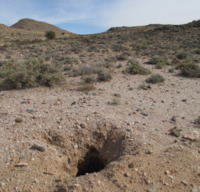
Holes
The landscape of the Karoo and the Northern Cape – the land of the |xam – is rich with holes in the ground. Below the surface of the earth burrowing animals navigate their way through the roots of grasses and shrubs, small trees and creepers. Holes are made and inhabited by scorpions and spiders, mice and shrews, suricats and mongooses. One of the most energetic of burrowers is the anteater whose holes, in places, transform the landscape. Anteaters are such active diggers and their holes so numerous that abandoned burrows are quickly occupied by bat-eared foxes, hyenas, hares, civets, bats, jackals, owls and porcupines (Skotnes 2010: 26) -
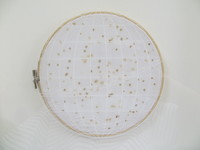
Amelia
"We are on the line 157 337. We will repeat this message. We will repeat this on 6210 kilocycles. Wait." On July 2, 1937 Model 10 Electra 1055 piloted by Amelia Earhart with navigator Fred Noonan took off from Lae Airfield, New Guinea and was never seen again. Earhart's last radio message was estimated to be within 200 miles of her destination Howland Island. Burn holes made with a magnifying glass on a handkerchief which corresponds to the positioning of the stars as observed from the place, date and time Amelia Earhart sent her last broadcast. -
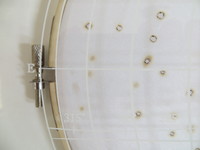
Amelia (detail)
"We are on the line 157 337. We will repeat this message. We will repeat this on 6210 kilocycles. Wait." On July 2, 1937 Model 10 Electra 1055 piloted by Amelia Earhart with navigator Fred Noonan took off from Lae Airfield, New Guinea and was never seen again. Earhart's last radio message was estimated to be within 200 miles of her destination Howland Island. Burn holes made with a magnifying glass on a handkerchief which corresponds to the positioning of the stars as observed from the place, date and time Amelia Earhart sent her last broadcast. -
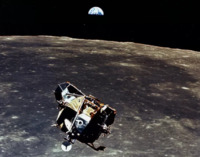
Moon landing
"FIZZY LIFTING DRINKS, it said on the next door. ‘Oh, those are fabulous!’ cried Mr Wonka. ‘They fill you with bubbles, and the bubbles are full of a special kind of gas, and this gas is so terrifically lifting that it lifts you right off the ground just like a balloon, and up you go until your head hits the ceiling – and there you stay.’ ‘But how do you come down again?’ asked little Charlie. ‘You do a burp, of course,’ said Mr Wonka. ‘You do a great big long rude burp, and up comes the gas and down comes you! But don’t drink it outdoors! There’s no knowing how high up you’ll be carried if you do that. I gave some to an old Oompa-Loompa once out in the backyard and he went up and up and disappeared out of sight! It was very sad. I never saw him again.’ ‘He should have burped,’ Charlie said. ‘Of course he should have burped,’ said Mr Wonka. ‘I stood there shouting, “Burp, you silly ass, burp, or you’ll never come down again!” But he didn’t or couldn’t or wouldn’t, I don’t know which. Maybe he was too polite. He must be on the moon by now’” (Dahl 1974: 95). -
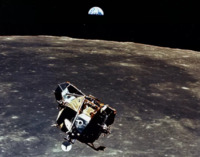
The Eagle has landed (Apollo 11 Lunar Module Ascent Stage Photographed from Command Module)
The Apollo 11 Lunar Module ascent stage, with Astronauts Neil A. Armstrong and Edwin E. Aldrin Jr. aboard, is photographed from the Command and Service Modules (CSM) during rendezvous in lunar orbit. The Lunar Module (LM) was making its docking approach to the CSM. Astronaut Michael Collins remained with the CSM in lunar orbit while the other two crewmen explored the lunar surface. The large, dark-colored area in the background is Smyth's Sea, centered at 85 degrees east longitude and 2 degrees south latitude on the lunar surface (nearside). This view looks west. The Earth rises above the lunar horizon. -

Dung beetles
Like ancient seafarers, dung beetles can navigate using the starry sky and the glow from the Milky Way. After locating a fresh pile of feces, dung beetles will often collect and roll away a large piece of spherical dung, then climb on their dung balls and dance around in circles before taking off. This dance is not one of joy, however; the insects are watching the sky to get their bearings. -

The Jaguar Shark
In Wes Anderson’s 2004 film, 'The Life Aquatic with Steve Zissou', Bill Murray plays the part of eccentric oceanographer, Steve Zissou. Zissou is both a parody of and homage to Jacques-Yves Cousteau, to whom the film is dedicated. The characters were inspired by The Great Gatsby and The Magnificent Ambersons, whilst the plot has been compared to Moby Dick. While filming a documentary, Steve’s partner and close friend, Esteban du Plantier, is eaten by a creature Zissou describes as a “Jaguar shark.” For his next project, Zissou orchestrates documenting the shark’s destruction.


